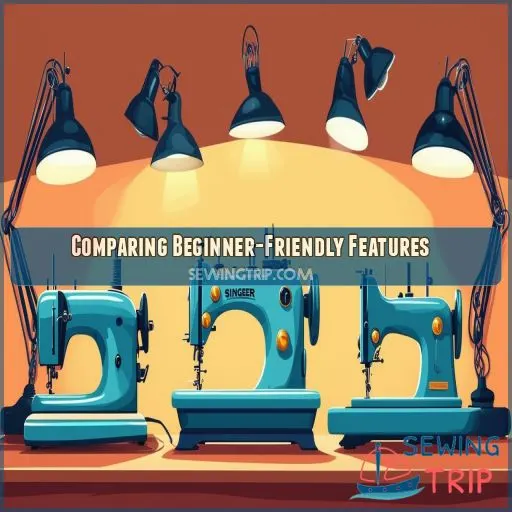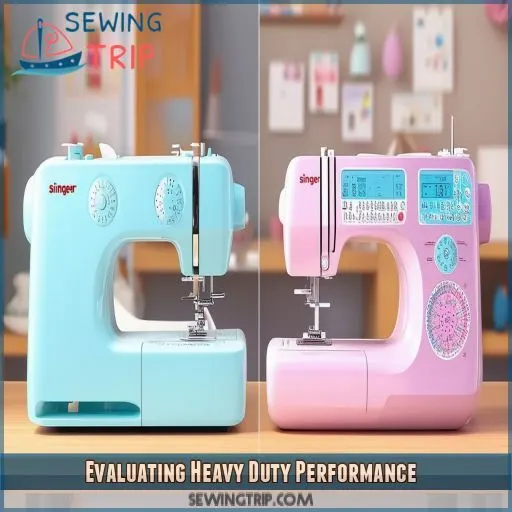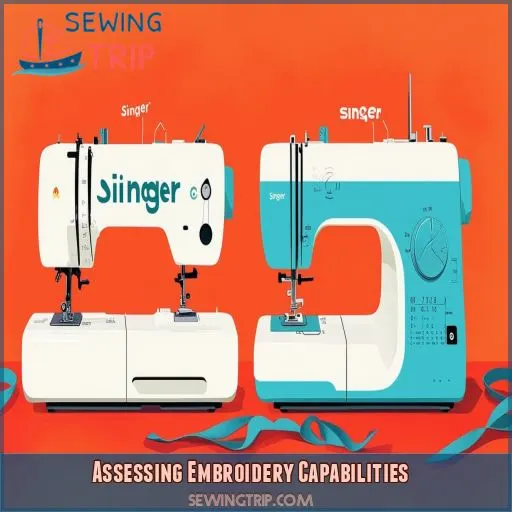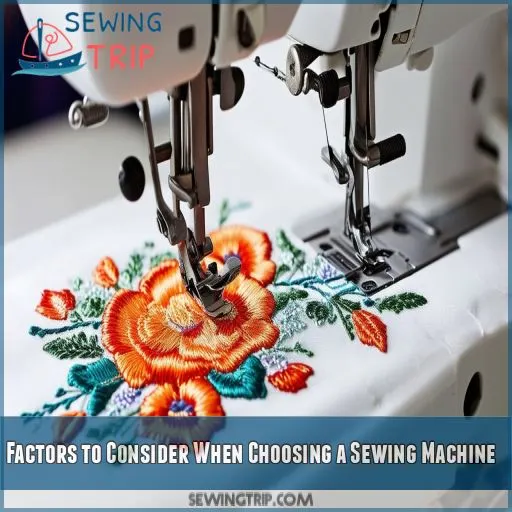This site is supported by our readers. We may earn a commission, at no cost to you, if you purchase through links.
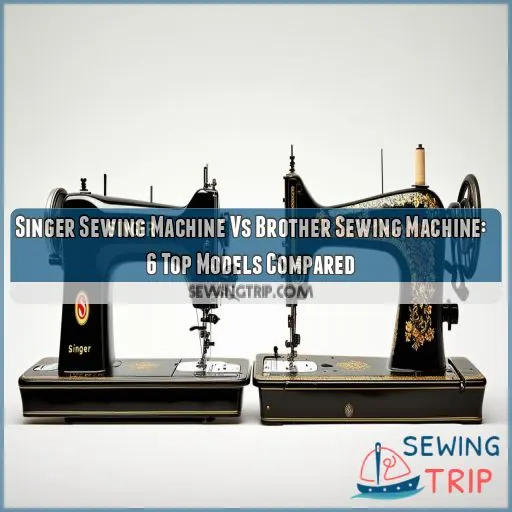
Singer’s 4411 Heavy Duty and 9960 models shine with their durable construction and abundant built-in stitches, perfect for extensive sewing projects.
Meanwhile, Brother machines offer user-friendly features like automatic needle threaders and LCD screens, ideal for beginners.
Both brands excel in embroidery capabilities, with Singer boasting a large variety of designs and Brother offering extensive editing options.
Consider your intended use, budget, and ease of use to find your perfect match.
Curious about which model might suit you best? Keep exploring!
Table Of Contents
Key Takeaways
When it comes to sewing machines, Singer and Brother are like two sides of a coin. Singer shines with its durability for heavy-duty projects, while Brother impresses with user-friendly features like automatic needle threaders. Both brands excel in embroidery, so whether you’re a seasoned pro or a newbie, there’s a machine for you.
Choosing between Singer and Brother depends on your sewing style. If you’re a denim-darning, quilt-making enthusiast, Singer’s robust construction will be your trusty sidekick. But if you’re a beginner looking for an easy-to-use machine with plenty of bells and whistles, Brother has got you covered.
When it comes to heavy-duty performance, Singer and Brother go toe-to-toe. Their metal frames and automatic features ensure durability and precision, so you can tackle any project with confidence. Plus, their embroidery capabilities will make your creations pop with vibrant designs.
Ultimately, the best sewing machine is the one that fits your needs and preferences. If you’re a seasoned pro seeking unwavering durability, Singer is your go-to. But if you’re a beginner looking for a user-friendly machine with plenty of features, Brother is the way to go. So, grab your thread, pick your machine, and let the creative sparks fly!
Top 6 Singer Sewing Machines
When comparing Singer sewing machines to Brother models, it’s helpful to examine Singer’s top offerings. Let’s look at six popular Singer machines: the 4411 Heavy Duty, Heavy Duty, 9960 Sewing Quilting Machine, Start 1304, M1500 Mechanical, and MX60 Sewing Machine Kit.
1. Singer 4411 Heavy Duty Sewing Machine
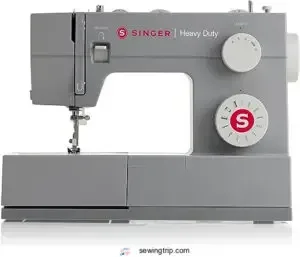
You’ll love the Singer 4411 Heavy Duty Sewing Machine if you’re looking for a powerhouse. With its sturdy metal frame and strong motor, it’ll breeze through 1,100 stitches per minute.
You’ve got 11 built-in stitches to play with, including 6 basic, 4 decorative, and 1 buttonhole. The adjustable presser foot control and free arm make it versatile for various projects.
While it lacks an automatic needle threader, its top-loading bobbin and clear cover make threading a cinch.
This workhorse is built to last, backed by a 25-year limited warranty.
Best For: Home sewers seeking a robust and reliable machine for everyday sewing projects.
- Heavy-duty metal frame ensures durability and stability.
- Strong motor (1,100 stitches per minute) for efficient sewing.
- Versatile with 11 built-in stitches, an adjustable presser foot, and a free arm.
- Lacks an automatic needle threader for added convenience.
- Stitch width is not adjustable for wide decorative stitches.
- No LCD screen for stitch selection or other settings.
2. Singer Heavy Duty Sewing Machine
You’ll find the Singer Heavy Duty Sewing Machine a powerhouse for your sewing projects. With 32 built-in stitches, including decorative and stretch options, you’re equipped for versatility. The automatic needle threader saves your eyes, while the 60% stronger motor tackles tough fabrics with ease.
You’ll breeze through projects at 1,100 stitches per minute, and the 6.25" sewing space gives you room to maneuver.
Plus, the included accessories like the walking foot and non-stick foot let you conquer layers and tricky materials. It’s a sturdy workhorse that’ll have you sewing like a pro in no time.
Best For: Home sewers seeking a durable, versatile, and powerful sewing machine.
- 32 built-in stitches for a variety of projects
- 60% stronger motor for handling tough fabrics
- 1,100 stitches per minute for fast sewing
- Limited to use in the US and Canada at 110 volts
- May be too bulky for smaller sewing spaces
- Not suitable for industrial-grade sewing
3. Singer 9960 Sewing Quilting Machine
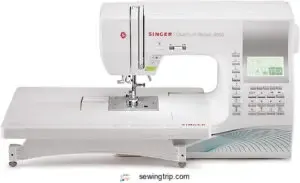
The Singer 9960 Sewing Quilting Machine is a powerhouse for your creative projects. You’ll love its 600 built-in stitches and 5 alphanumeric fonts, giving you endless design possibilities.
With a maximum speed of 850 stitches per minute, you’ll breeze through tasks in no time. The automatic needle threader and quiet operation make sewing a joy, while the heavy-duty construction ensures durability.
Although it might take some practice to master the threading process, the versatility and value you’ll get from this machine are well worth the effort.
Best For: Creative individuals seeking a versatile and durable sewing machine for a wide range of projects.
- Impressive array of 1,172 stitch applications, including 600 built-in stitches
- Automatic needle threader for effortless threading
- High-speed sewing at 850 stitches per minute
- May require some practice to master the threading process
- Does not include a 1/4" seam foot
- Extended table is not included but can be purchased separately
4. Singer Start 1304 Sewing Machine
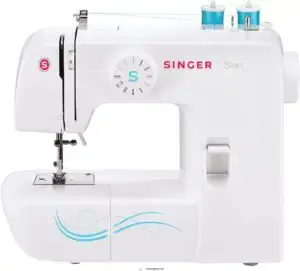
The Singer Start 1304 Sewing Machine is perfect for beginners, offering simplicity and practicality. With six built-in stitches and preset stitch width and length, you’ll find it easy to get started on basic projects.
Lightweight and portable at 7 pounds, it’s great for on-the-go sewing. Features like the automatic bobbin winding add to the convenience.
However, it may not be ideal for heavy-duty tasks. This model is affordable, user-friendly, and a solid choice for those new to sewing.
Best For: Beginners and occasional sewers looking for a budget-friendly and easy-to-use machine.
- Affordable at under $100
- Lightweight and portable (7 lbs)
- Automatic bobbin winding
- Limited stitch variety compared to higher-end machines
- May not be suitable for heavy-duty projects like upholstery or quilting
- May require practice to achieve straight stitches
5. Singer M1500 Mechanical Sewing Machine
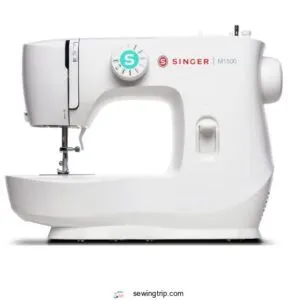
The Singer M1500 Mechanical Sewing Machine is ideal for beginners. It’s user-friendly, featuring preset stitch length and width, granting seamless operation.
With 57 stitch applications, it accommodates diverse sewing needs from quilting to crafts. The robust full metal frame guarantees durability, while the front-loading bobbin system simplifies threading.
Despite its dependable performance, the machine can occasionally jam, and not all threads are compatible. Nevertheless, its straightforward design makes it an excellent choice for novices.
Best For: Beginners looking for an easy-to-use, reliable sewing machine.
- User-friendly with preset stitch length and width
- Durable construction with a full metal frame
- Front-loading bobbin for easy threading
- Can jam
- Not all threads are compatible
- Can be slow
6. Singer MX60 Sewing Machine Kit
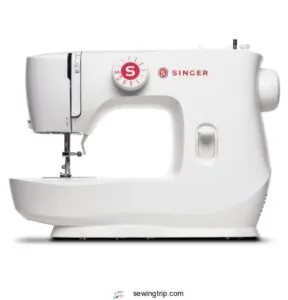
The Singer MX60 Sewing Machine Kit is perfect for beginners due to its ease of use and lightweight design. It offers 57 stitch applications, an easy stitch selection, and pre-set stitch length and width.
Despite its compact build, it can sew through multiple fabric layers, making it versatile. Key features include LED lighting and a full metal frame for durability, but it lacks an automatic needle threader and has a front-load bobbin.
Its portability and user-friendly features make it a great starter machine.
Best For: Beginners seeking a user-friendly and portable sewing machine for various projects.
- Easy stitch selection and pre-set stitch length and width
- Can sew through multiple layers of fabric
- Lightweight and portable design
- No automatic needle threader
- Front-load bobbin
- Cheap-feeling pedal
Comparing Beginner-Friendly Features
When comparing beginner-friendly features, it’s essential to examine ease of use, the number of built-in stitches, and the automatic needle threader. These aspects will help you determine which machine better suits your learning curve and sewing needs.
Ease of Use
When comparing the ease of use between Singer and Brother machines, you’ll find distinct advantages. Singer models highlight easy threading and consistent tension settings, perfect for those starting out. Brother excels with features like automatic needle threader and easy stitch selection through an LCD screen. Both guarantee excellent fabric compatibility and stitch quality, simplifying sewing projects.
Number of Built-in Stitches
When comparing the number of built-in stitches between Singer and Brother sewing machines, it’s essential to examine:
- Singer models, like the Singer 9960, offer up to 600 stitches, providing vast versatility.
- Brother machines, such as the Brother CS6000i, deliver around 70 stitches, balancing functionality and simplicity.
- Both brands guarantee high stitch quality with adjustable stitch length and width ranges, accommodating various projects.
Automatic Needle Threader
Finding the right sewing machine for beginners often hinges on user-friendly features like the automatic needle threader. Singer’s models generally offer more intuitive threading guides, making it simpler for novices to use. Brother machines, renowned for their innovation, also incorporate helpful features, but often include added complexity with their threading, tension dial, and needle positioning options which may challenge beginners.
Evaluating Heavy Duty Performance
When evaluating heavy-duty performance in sewing machines, it’s essential to take into account metal frame construction, automatic needle stop position, and automatic presser foot pressure adjustment. These features guarantee durability and consistent sewing quality, providing reliable performance for demanding projects.
Metal Frame Construction
Evaluating heavy duty performance begins with metal frame construction. Both Singer and Brother offer machines with a durable metal frame, enhancing:
- Durability: Guarantees longer life despite rigorous use.
- Quality: Provides stability and reduces vibrations.
- Maintenance: Easier to clean and maintain.
- Aesthetics: Sleek, professional look, perfect for heavy-duty tasks.
Automatic Needle Stop Position
The automatic needle stop position allows you to halt stitching with the needle either up or down, boosting precision. On a Singer sewing machine, this feature guarantees superior needle piercing power and accurate stitch length adjustment. Brother sewing machines often incorporate it alongside automatic bobbin loading and thread tension settings, catering to detailed sewing projects and demanding tasks.
Automatic Presser Foot Pressure Adjustment
Automatic Presser Foot Pressure Adjustment is vital for heavy-duty performance. It guarantees even stitching across various fabrics. Consider:
- Fabric Thickness Adjustment: Adjusts pressure for denim to silk.
- Material Sensitivity: Prevents fabric pulling or puckering.
- Specialty Stitches: Ideal for serging, rolled hems.
- Convenience: Automatic adjustment—no manual tweaking needed.
This feature makes your sewing experience seamless and efficient.
Assessing Embroidery Capabilities
Evaluating the embroidery capabilities of Singer and Brother sewing machines involves examining the number of built-in designs, hoop size, editing software, and automatic thread trimmer. You’ll find Brother machines often excel with more built-in designs and advanced software, while Singer offers robust automatic features to simplify your projects.
Number of Built-in Embroidery Designs
Singer machines typically boast a vast embroidery design variety, such as in the Singer 9960 with 600 stitches, making them versatile for intricate stitch pattern selection. However, Brother embroidery models, like the Brother SE600, offer extensive design editing options, ensuring customizable embroidery. Both brands also support monogram suitability, appealing to those seeking detailed embroidery features in their sewing machine models.
Embroidery Hoop Size
When evaluating embroidery capabilities, embroidery hoop size is essential. It defines the embellishment area for your fabric and affects overall stitch quality.
- Design Size Flexibility: Larger hoops accommodate larger designs.
- Fabric Hooping Simplicity: Ample space makes securing fabric easier.
- Computerized Accuracy: Confirm your machine’s differential feed and needle stabilizer adapt properly to your hoop size.
Embroidery Editing Software
Choosing embroidery machines requires considering embroidery design software. While Brother excels with its easy-to-use features, Singer offers extensive embroidery pattern digitizing and stitch editing software. Whether you’re converting thread colors or ensuring embroidery hoop compatibility, both brands deliver. Brother’s user-friendly programs might be your go-to, but Singer’s detailed tools provide unparalleled design flexibility and precision.
Automatic Thread Trimmer
The automatic thread trimmer is a game-changer for embroidery enthusiasts. It efficiently cuts both top and bobbin threads, saving you time and reducing thread jams. This feature, found in advanced Singer and Brother sewing machines, complements other capabilities like automatic thread winding, needle position control, stitch length adjustment, and bobbin sensors, enhancing your sewing experience.
Factors to Consider When Choosing a Sewing Machine
When choosing a sewing machine, consider what you’ll use it for, whether it’s sewing, quilting, or embroidery. Additionally, evaluate your budget, brand reputation, customer support, ease of use, and the learning curve.
Intended Use (sewing, Quilting, Embroidery)
When picking the right sewing machine, consider the intended use:
- Free-motion sewing and appliqué quilting: Look for adjustable feed dogs.
- Garment construction: Prioritize machines with multiple buttonhole making options.
- Pattern matching: Choose a model with precise stitch control.
- Embroidery: Opt for machines with built-in designs, like Brother’s specialized lineup.
Budget
Budget is important when choosing between Singer and Brother sewing machines. Consider the price point, warranty information, and included accessories. Singer models tend to be pricier but offer robust construction and lasting performance. Brother models are generally more affordable, often boasting more features. Factor in customer satisfaction and brand loyalty when evaluating your investment in Singer vs Brother sewing machines.
Brand Reputation and Customer Support
When choosing a sewing machine, consider brand reputation and customer support. Singer boasts durable, high-quality machines, fostering brand loyalty. Brother offers impressive technical support and innovative features. Both brands offer solid warranty options and straightforward return policies. Customer satisfaction is high for both, but Singer enthusiasts praise enduring quality while Brother devotees tout excellent repair services and responsive support.
Ease of Use and Learning Curve
When comparing Singer and Brother sewing machines, ease of use and the learning curve are essential. Singer machines are straightforward for beginners, while Brother offers more features with a steeper learning curve.
- Portability and weight: Will you carry it often?
- Stitch selection: Does it meet your project needs?
- Thread tension: Is it easy to adjust?
Frequently Asked Questions (FAQs)
What is the difference between a Singer and brother sewing machine?
Singer machines are renowned for their durability and build quality, ideal for heavy-duty work. Brother machines typically offer more advanced features and affordability, with a focus on computerized models and versatile embroidery options.
What is the most reliable brand of sewing machine?
Regarding reliability, Singer and Brother are both excellent choices. While Singer is often hailed for its durability and lifespan, Brother machines excel in their innovative features and user-friendly interfaces. It’s a difficult choice to make.
How long do Brother sewing machines last?
Brother sewing machines typically last 10-25 years, depending on usage and maintenance. Regular servicing and proper care can extend their lifespan, ensuring reliable performance and durability for all your sewing projects.
Which sewing machine is the strongest?
Wondering which sewing machine packs the most punch? For ultimate strength and durability, Singer’s heavy-duty models, like the Singer 4411, are top contenders. Built to withstand tough fabrics, they’re your go-to workhorses.
Are singer & Brother Sewing machines the same?
Singer and Brother sewing machines aren’t the same. Singer offers durable, high-quality machines, while Brother focuses on affordability and features like computerized LCD screens. Both brands cater to different user needs and preferences.
Is singer a better sewing machine?
Singer sewing machines are better for durability and long-term use, making them ideal for heavy-duty projects. However, Brother machines often offer more features and better value for various sewing needs, especially for beginners.
Which is better brother or singer embroidery machine?
Brother excels in embroidery with its advanced computerized technology, extensive built-in patterns, and Wi-Fi/USB features, making it ideal if you’re looking for innovation. Singer offers robust, high-quality machines for long-term durability.
Are Singer machines better than brothers?
When considering whether Singer machines are better than Brother, it boils down to your needs. Singer offers durability and quality, while Brother provides affordability and features. Evaluate your priorities to determine the best fit.
How did singer become synonymous with home sewing machines?
Singer revolutionized home sewing with innovative payment plans, extensive marketing campaigns, and strategic partnerships. Their accessible machines and affordability allowed households to own reliable sewing devices, embedding the Singer brand deeply into the fabric of domestic life.
How do Singers sewing machines handle delicate fabrics?
Singer sewing machines handle delicate fabrics with precision. Their adjustable presser foot pressure, fine-tuned stitch settings, and smooth feed mechanisms guarantee consistent, even stitches without damaging the fabric’s delicate texture.
What are the longevity differences between brands?
Singer’s machines are built to weather the storm like a sturdy ship, known for their durability and longevity. Brother’s machines, while feature-rich and innovative, generally have shorter lifespans but excel in advanced functionalities.
Can both brands machines handle serging tasks?
Yes, both Singer and Brother machines can handle serging tasks efficiently. They offer models with serging capabilities, though Singer machines are known for their sturdier construction, while Brother machines often provide more advanced features.
Are there significant differences in machine noise levels?
Both brands generally produce machines with comparable noise levels, but specific models might vary. Typically, Brother machines are slightly quieter, making them a better choice if noise is a significant concern for you.
How user-friendly is the customer support?
You’ll find Singer’s customer support user-friendly, with clear troubleshooting guides and prompt responses. For instance, Jane resolved her bobbin issue within minutes using Singer’s live chat, showcasing their commitment to effective, accessible assistance for users.
Conclusion
Exploring the realm of sewing machines can feel like stitching a complex pattern.
Understanding the key differences between a Singer sewing machine vs Brother sewing machine helps.
Both brands offer exceptional models catering to varied needs, whether you prioritize durability or beginner-friendly features.
By focusing on aspects such as heavy-duty performance, embroidery capabilities, and budget, you can find the ideal machine to match your requirements.
Explore your options well, and happy sewing!

